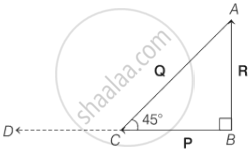Advertisements
Advertisements
Question
The resultant `vec"R"` of `vec"P"` and `vec"Q"` is perpendicular to `vec"P"`. Also `|vec"P"|=|vec"R"|`. The angle between `vec"P"` and `vec"Q"` is ______.
[tan 45° = 1]
Options
`(5pi)/4`
`(7pi)/4`
`(pi)/4`
`(3pi)/4`
Solution
The resultant `vec"R"` of `vec"P"` and `vec"Q"` is perpendicular to `vec"P"`. Also `|vec"P"|=|vec"R"|`. The angle between `vec"P"` and `vec"Q"` is `underlinebb((3pi)/4)`.
Explanation:
Given that R is resultant of `vec"P"` and `vec"Q"` as shown in the figure below,
BC = P, CA = Q and BA = R

Given, BA and BC are perpendicular and equal in magnitude. So, from property of triangle,
∠ACB = 45°
Now, BC has to be extended up to D so,
that CD = P
Now, CD and CA have the initial point C, so the angle between CD and CA;
= 180° - 45° = 135° = `(3pi)/4`
So, angle between `vec"P"` and `vec"Q"` is `(3pi)/4`.
